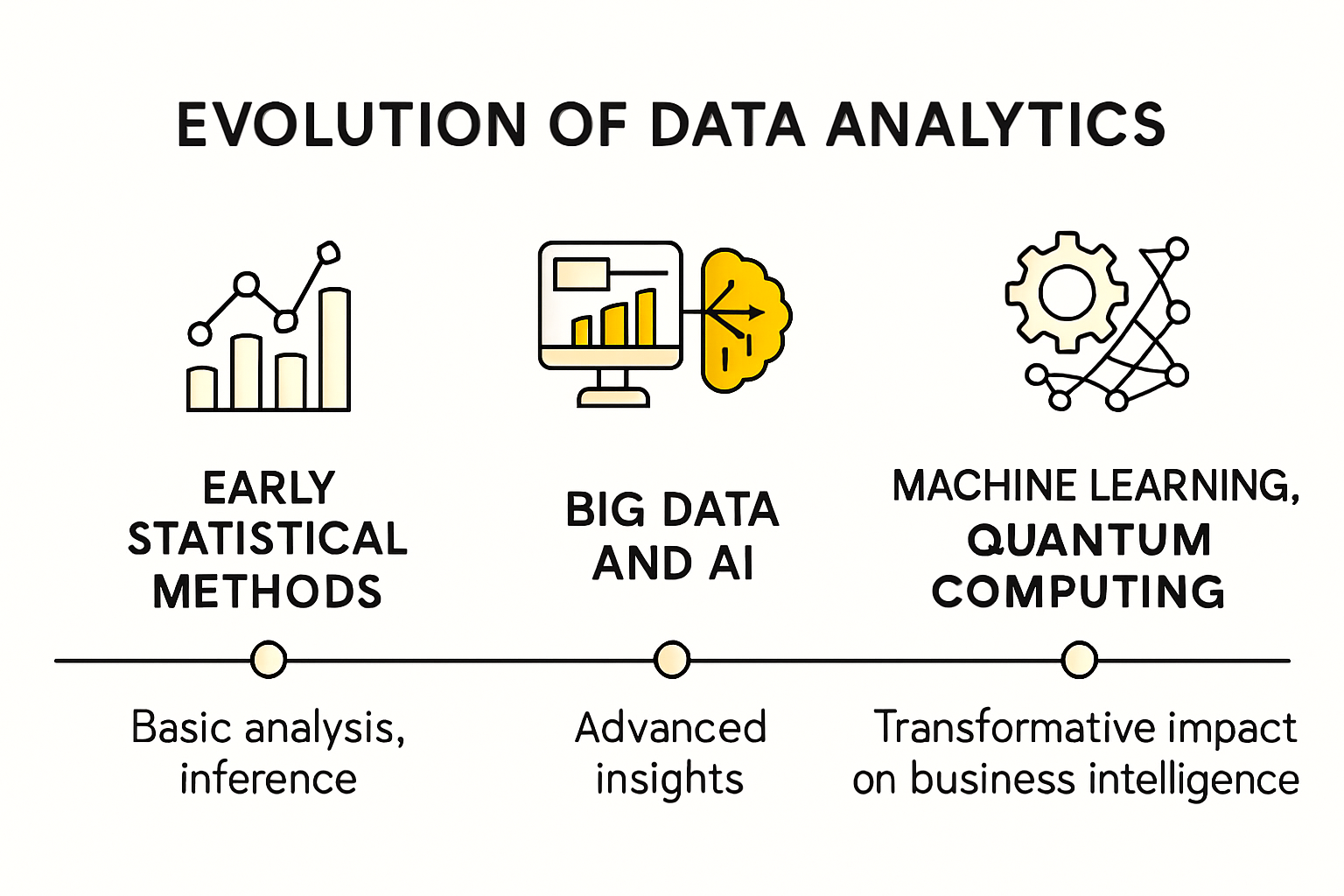Data analytics is at the heart of nearly every business success story today and shapes how companies understand their customers and predict the future.
It sounds technical and intimidating. But surprisingly, the most influential leaps in analytics come not just from complex maths but from the incredible fusion of technologies like artificial intelligence and quantum computing. That means the real story is about how these evolving tools are quietly changing the rules for everyone from retailers to hospitals.
Table of Contents
- What Is Data Analytics And Its Evolution?
- Why The Future Of Data Analytics Matters For Businesses
- How Emerging Technologies Shape Data Analytics.
- Key Concepts In Data Analytics For E-Commerce And Marketing
- Practical Applications Of Data Analytics In Today's Market
Quick Summary
| Takeaway | Explanation |
|---|---|
| Data analytics drives competitive advantage. | Effective use of data analytics allows companies to make informed decisions, understand market dynamics, and predict trends accurately. |
| Integrate emerging technologies for insights. | Leveraging AI, machine learning, and advanced computational methods can enhance data processing, identify patterns, and reduce biases in analytics. |
| Utilize predictive modeling for customer insights. | Predictive analytics helps forecast customer behaviors and preferences, enabling personalized marketing and improved customer engagement. |
| Streamline operations through data insights. | Data analytics can uncover inefficiencies, optimize workflows, and enhance overall business performance by tracking key performance indicators. |
| Data analytics is essential across industries. | Industries including healthcare, retail, and finance are leveraging analytics to enhance efficiency and decision-making, demonstrating its broad applicability. |
What is Data Analytics and Its Evolution?
Data analytics represents a sophisticated process of examining, cleaning, transforming, and interpreting raw data to uncover meaningful insights, patterns, and trends that can drive strategic business decisions. At its core, data analytics transforms complex information into actionable intelligence, enabling organizations to understand their performance, predict future outcomes, and optimize their operations.
Origins and Technological Progression
The roots of data analytics trace back to early statistical methods and computational technologies.

According to research from the University of Minnesota, data analysis has undergone significant transformations across different technological eras:
- 1940s-1960s: Introduction of mainframe computers
- 1980s-1990s: Development of client-server systems and relational databases
- 1990s-2005: Emergence of internet technologies and non-relational databases
- 2005-2015: Rise of social media and cloud computing platforms
- 2015-Present: Integration of Internet of Things and advanced data platforms
Modern Business Intelligence
Today, data analytics has evolved from a niche technical discipline to a critical business function. Companies now leverage sophisticated tools for understanding marketing data that enable rapid decision-making. Modern data analytics encompasses multiple approaches, including descriptive analytics (what happened), diagnostic analytics (why it happened), predictive analytics (what might happen), and prescriptive analytics (how we can make it happen).
Businesses utilize data analytics to understand customer behavior, optimize marketing strategies, improve operational efficiency, and identify potential risks and opportunities. The ability to transform raw data into strategic insights has become a fundamental competitive advantage in the digital economy.
Why the Future of Data Analytics Matters for Businesses
In an increasingly digital landscape, data analytics has transformed from a supplementary business function to a critical strategic asset. Organizations that effectively leverage data analytics gain substantial competitive advantages by making informed decisions, understanding complex market dynamics, and predicting future trends with remarkable precision.
Strategic Decision Making
Research from Georgetown University highlights that big data provides invaluable insights enabling organizations to make better-informed business decisions for long-term sustainability. By analyzing historical and real-time data, businesses can:
- Understand intricate market dynamics
- Predict customer behavior patterns
- Identify emerging market opportunities
- Mitigate potential operational risks
Performance and Efficiency Optimization
Data analytics enables businesses to streamline operations, reduce inefficiencies, and allocate resources more strategically. Explore our comprehensive guide on analytics trends to understand how advanced analytical techniques can transform business performance. Cutting-edge data analytics tools help organizations identify bottlenecks, optimize workflows, and enhance overall operational productivity.
Moreover, data analytics provides a powerful mechanism for continuous improvement. By tracking key performance indicators and generating actionable insights, businesses can adapt quickly to changing market conditions, customer preferences, and technological advancements. The ability to transform raw data into strategic intelligence has become a fundamental differentiator in today's competitive business ecosystem.
How Emerging Technologies Shape Data Analytics.
Emerging technologies are fundamentally transforming the landscape of data analytics, creating unprecedented opportunities for businesses to extract deeper, more meaningful insights from complex data ecosystems. These technological advancements are not merely incremental improvements but represent radical shifts in how organizations approach data interpretation and strategic decision-making.
Artificial Intelligence and Machine Learning
According to MIT Technology Review, artificial intelligence and machine learning are revolutionizing data analytics by enabling more sophisticated, predictive, and autonomous data processing. AI-driven analytics can now:
- Automatically identify complex patterns invisible to human analysts
- Generate real-time predictive models with high accuracy
- Adapt and learn from incoming data streams
- Reduce human bias in data interpretation
Advanced Computational Techniques
Quantum computing and edge computing are emerging as game-changing technologies in data analytics. These advanced computational approaches enable faster processing of massive datasets, allowing businesses to analyze information at speeds previously considered impossible. Learn more about emerging analytics technologies that are reshaping business intelligence.
Moreover, the convergence of big data, cloud computing, and advanced algorithmic techniques is creating a more dynamic, responsive analytics ecosystem. Businesses can now leverage real-time data processing, sophisticated machine learning models, and predictive analytics to gain instantaneous insights, driving more agile and intelligent strategic decision-making across various organizational functions.
Key Concepts in Data Analytics for E-commerce and Marketing
Data analytics has become the cornerstone of strategic decision-making in digital commerce, providing businesses with nuanced insights into customer behavior, market trends, and operational performance. By leveraging sophisticated analytical methodologies, organizations can transform raw data into actionable intelligence that drives competitive advantage.
Customer Behaviour and Predictive Modelling.
Research from Springer's systematic review demonstrates that big data analytics in e-commerce enables businesses to understand complex customer interactions and predict future purchasing patterns. Predictive modeling techniques allow organizations to anticipate customer needs with remarkable precision, enabling personalized marketing strategies. Key applications include:
- Forecasting individual customer lifetime value
- Identifying potential churn risks
- Developing personalized product recommendations
- Segmenting customers based on behavioral attributes
Advanced Analytics Methodologies
Discover advanced e-commerce analytics techniques that transform raw data into strategic insights. Modern e-commerce and marketing analytics encompass multiple sophisticated approaches, including:
- Machine learning algorithms for pattern recognition
- Sentiment analysis of customer feedback
- Real-time performance tracking
- Cross-channel customer journey mapping
By integrating these advanced analytical methodologies, businesses can create more responsive, customer-centric strategies that adapt dynamically to changing market conditions and individual consumer preferences.

Practical Applications of Data Analytics in Today's Market.
Data analytics has transitioned from a theoretical concept to a powerful operational tool across multiple industries, enabling organizations to make precise, data-driven decisions that drive efficiency, innovation, and competitive advantage. By transforming raw information into strategic insights, businesses can now navigate complex market landscapes with unprecedented clarity and confidence.
Strategic Business Intelligence
Research from the Financial Times highlights how academic research is driving tangible industry innovations through advanced data analytics. Organizations are leveraging analytical capabilities to:
- Optimize supply chain management
- Predict market trends with higher accuracy
- Enhance customer experience through personalization
- Reduce operational costs through predictive maintenance
Cross-Industry Data Analytics Applications
Modern data analytics transcends traditional industry boundaries, offering transformative insights across sectors. Explore comprehensive analytics strategies that can revolutionize business performance. Different industries demonstrate remarkable applications:
- Healthcare: Predicting patient outcomes and optimizing treatment protocols
- Utilities: Forecasting infrastructure maintenance and energy consumption
- Retail: Creating personalized marketing campaigns and inventory management
- Finance: Detecting fraudulent transactions and assessing credit risks
By embracing data analytics, organizations can convert complex information into actionable strategies, driving innovation and maintaining a competitive edge in rapidly evolving market environments.
Unlock the True Power of Your Data in E-commerce
If you are concerned about lost conversions or incomplete data signals, you are not alone. As discussed in "Understanding the Future of Data Analytics for Businesses," many companies struggle with the accuracy and reliability of traditional analytics, especially as data privacy rules tighten and browser restrictions increase. Without precise conversion tracking and real insight into your customers, even advanced analytics can fall short of delivering real business value.

Now is the time to act. AdPage empowers you to bridge these gaps with server-side tagging, robust consent management, and seamless integration with leading e-commerce platforms. Monitor one hundred percent of your conversions, protect data compliance, and drive higher performance from your analytics tools. Take control and experience the difference. Start optimising your tracking system today with AdPage's trusted solutions.
Frequently Asked Questions
What is data analytics?
Data analytics is the process of examining, cleaning, transforming, and interpreting raw data to uncover meaningful insights, patterns, and trends that inform strategic business decisions.
How has data analytics evolved over time?
Data analytics has evolved through various technological eras, from early statistical methods and mainframe computers in the 1940s to the integration of AI and advanced data platforms in the present.
Why is data analytics important for businesses?
Data analytics allows businesses to understand customer behavior, optimize operations, predict market trends, and enhance strategic decision-making, giving them a competitive advantage in the digital economy.
What are the different types of data analytics?
The main types of data analytics include descriptive analytics (what happened), diagnostic analytics (why it happened), predictive analytics (what might happen), and prescriptive analytics (how to make it happen).



.png)
